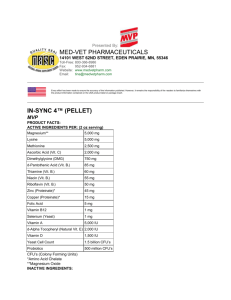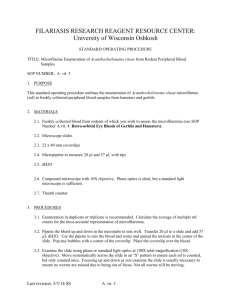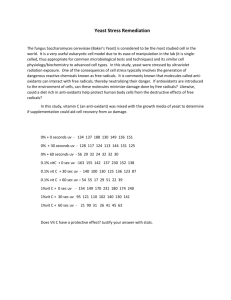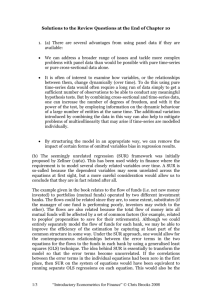SIMPLE ENDOGENOUS BINARY CHOICE AND SELECTION PANEL MODEL ESTIMATORS Arthur Lewbel
advertisement
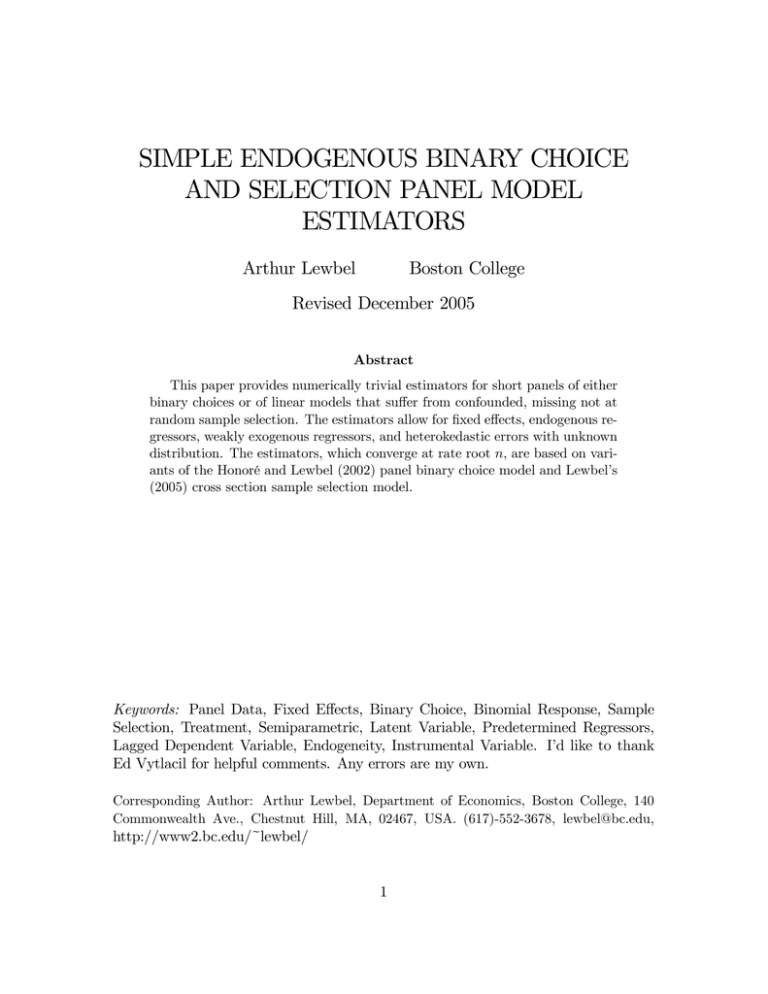
SIMPLE ENDOGENOUS BINARY CHOICE
AND SELECTION PANEL MODEL
ESTIMATORS
Arthur Lewbel
Boston College
Revised December 2005
Abstract
This paper provides numerically trivial estimators for short panels of either
binary choices or of linear models that suffer from confounded, missing not at
random sample selection. The estimators allow for Þxed effects, endogenous regressors, weakly exogenous regressors, and heterokedastic errors with unknown
distribution. The estimators, which converge at rate root n, are based on variants of the Honoré and Lewbel (2002) panel binary choice model and Lewbel’s
(2005) cross section sample selection model.
Keywords: Panel Data, Fixed Effects, Binary Choice, Binomial Response, Sample
Selection, Treatment, Semiparametric, Latent Variable, Predetermined Regressors,
Lagged Dependent Variable, Endogeneity, Instrumental Variable. I’d like to thank
Ed Vytlacil for helpful comments. Any errors are my own.
Corresponding Author: Arthur Lewbel, Department of Economics, Boston College, 140
Commonwealth Ave., Chestnut Hill, MA, 02467, USA. (617)-552-3678, lewbel@bc.edu,
http://www2.bc.edu/~lewbel/
1
1
Introduction
This paper starts from the same set of conditions as those used by Honoré and Lewbel
(2002) for identiÞcation of the parameters of a binary choice model with individual
speciÞc effects and explanatory variables that are predetermined as opposed to strictly
exogenous. Their associated estimator, which converges at rate root n, requires high
dimensional nonparametric Þrst step. The present paper Þrst proposes numerically
simpler estimators for this model, based on parameterizing a model of one regressor.
A related identiÞcation concept for cross section selection models proposed by Lewbel
(2005) is then extended to panel models, and is similarly simpliÞed by parametrically
or semiparametrically modeling one regressor.
First consider the binomial response (binary choice) panel model
yit = I(vit + x0it β + αi + (it > 0)
(1)
where i = 1, 2, . . . , n, and t = 1, 2, . . . , T . The asymptotics to be considered is T
Þxed and n → ∞. Here I(·) is the indicator function that equals one if · is true
and zero otherwise, vit is a regressor having a coefficient that has been normalized to
equal one, xit is a J vector of other regressors, β is a J vector of coefficients, αi is an
individual speciÞc (“Þxed”) effect, and the distribution of the errors (it is unknown.
We will speak of αi as being drawn from some distribution, but it will be treated as
a Þxed effect in that no attempt is made to model this distribution, and αi will be
differenced out to estimate β.
The model (1) was considered by Rasch (1960) and by Andersen (1970) who
showed that the parameter β can be estimated by a conditional likelihood approach
provided that the errors, {(it }, are independent and logistically distributed and independent of the sequence of explanatory variables {vit , xit }. Manski (1987) generalized
this approach by showing that β can be estimated by a conditional maximum score
approach as long as the sequence {(it } is stationary conditional on the sequence
of explanatory variables {vit , xit }. Honoré and Kyriazidou (2000) generalized the
approaches of Rasch (1960), Andersen (1970) and Manski (1987) by considering a
binary choice model with strictly exogenous explanatory variables as well as lagged
dependent variables. Honoré and Lewbel (2002) allows for general predetermined
explanatory variables (not just lagged dependent variables) and results in a root-n
consistent estimator, as opposed to the slower rate of Honoré and Kyriazidou’s estimator. The cost is that a strong assumption is made on one of the explanatory
variables vit . By permitting estimation of β in (1) at rate root—n, this assumption
also overcomes a result by Chamberlain (1993) who showed that even if all the explanatory variables are strictly exogenous and the distribution of (it in (1) is known,
the logit model is the only version of (1) in which β can be estimated at rate root-n.
Honoré and Lewbel (2002) works by applying the cross section binary choice estimator
of Lewbel (2000) to construct a linear moment condition from (1), and then applies
standard methods used for linear panel data models to the resulting linear moment
2
condition. In particular, this allows for predetermined and endogeneous regressors
exactly as in linear models.
The key assumption is that αi +(it in (1) is conditionally independent of one of the
explanatory variables, vit . This assumption is strong. However, given Chamberlain’s
result it is clear that some additional assumption is needed in order to construct
estimators that are root—n consistent.1 The requirement is conditional independence.
This means that when the value of xit (and instruments zi ) are known, additional
knowledge of the one regressor vit does not alter the conditional distribution of αi +(it .
This assumption is similar to Hausman and Taylor (1981), but differs from theirs
because their assumption is unconditional.
Whether the assumption made here is reasonable depends on the context. It
will naturally arise in applications where −vit is some cost measure and x0it β + αi is
some beneÞt measure, or vice versa. Adams, Berger and Sickles (1999) argue that
such an assumption is appropriate in a particular linear model of bank efficiency.
In labor supply or consumer demand models, where the errors and Þxed effects are
interpreted as unobserved ability or preference attributes, the assumption will hold
if there exists explanatory variables that are assigned to individuals independently
of these unobserved attributes (an example might be government beneÞts income).
Maurin (1999) applies a similar conditional independence assumption in a model of
whether students repeat a grade in elementary school, using date of birth as the
special regressor, and Alonso, Fernandez, and Rodriguez-Póo (1999) use age as the
independent regressor in a duration model application. Explanatory variables based
on experimental design, as in Lewbel, Linton, and McFadden (2001), would also
satisfy the assumption. On the other hand, it is clearly not a reasonable assumption
in a structural model of the type considered by Heckman and MaCurdy (1980) where
the Þxed effect is related to all the explanatory variables by construction.
The estimator permits endogeneity or weak exogeneity of xit . It also permits xit
to contain lagged dependent variables such as yit−1 , however, in that case the required
conditional independence of vit will limit the extent of permitted autocorrelation in
vit , since yit−1 depends on vit−1 . The moment conditions that the estimator is based on
can also be applied separately to each time period, so the model can be immediately
extended to replace β with β t . This Þts the model as described where xit includes
time dumies, or time dummies interacted with xit regressors.
1
In some situations it may be more appropriate to take a random effects approach like the one in
Chen, Heckman and Vytlacil (1998). Such an approach typically requires assumptions about initial
conditions, and about the relationship between the individual speciÞc effect and the explanatory
variables, but these additional assumptions often lead to much more precise estimators (if they are
satisÞed). As pointed out by Wooldridge (2001) such an approach also leads to parameters that
are more easily interpretable. Arellano and Carrasco (2000) propose methods for a different panel
data discrete choice model that the one considered here. Their model is less general than ours, but
their approach captures many of the desirable features of both Þxed and random effects. The class
of models and parameters considered by Altonji and Matzkin (2000) is in some ways more general
than ours, but although endogeneity is permitted, their model cannot accomodate dynamics.
3
The second model to be considered is a panel selection or treatment model
yit = I(0 ≤ vit + M(x0it , αi , (it ) ≤ A)
(2)
pit = (vit β v + x0it β x + ci + eit )yit
(3)
So pit is some outcome we wish to model, and yit indexes whether an individual i
is selected or treated in time t, or more generally indexes if pit is observed. Let
p∗it = vit β v + x0it β x + αi + eit . If p∗it is observed then it equals pit and yit = 1, otherwise
pit = yit = 0, and in that case p∗it is what pit would have equaled if it had been
observed, which could be a counterfactual. For example, in a classic wage model
(Gronau 1974, Heckman 1974, 1976), yit = 1 if individual i is employed in time t, p∗it
is the wage individual i would get if employed in time t, and pit is the observed wage,
which is zero for the unemployed. Both p∗it and yit depend on observable covariates
such as measures of schooling or training, but they may also depend on common
unobservables such as ability, so errors eit and (it and Þxed effects αi and ci can all be
correlated with each other in unknown ways, meaning that the selection or treatment
is confounded and nonignorable.
The goal for the selection model is estimation of β = β v , β x . The unknown
Mit = M(x0it , ci , (it ) will not need to be parameterized or estimated. Common models
of selection are special cases of equation (2) in which A is inÞnite. In a wage model,
the typical assumption is that one chooses to work if the gains in utility from working,
indexed by the latent vit + Mit , are sufficiently large. Examples in which A is Þnite
arise in ordered treatment or ordered selection models. For example, if an ordered
choice model with latent variable vit +Mit determines an individual’s years of schooling
and yit indexes having exactly 12 years of schooling then individuals with vit +Mit < 0
choose 11 or fewer years while those with vit + Mit > A choose 13 or more years. We
might then be interested in modelling the returns pit from having just 12 years of
schooling. The lower bound of zero is a free normalization.
The next section summarizes Honoré and Lewbel’s theorem for identiÞcation of
β in the binary choice panel model by expressing it as a function of estimable data
densities and expectations. Simple root n consistent estimators are then provided.
Next the selection model identiÞcation result, which is a panel extension of Lewbel
(2004), is provided along with its corresponding simple estimators.
2
Binary Choice IdentiÞcation
To ease exposition, for this section the theoretical results will be presented using a
single pair of time periods, r and s, and a corresponding vector of instruments zi ,
which is assumed to be uncorrelated with (it in both periods. zi would typically consist
of predetermined regressors up to period min {r, s}, although other instruments could
be used (including time—invariant ones). The simple estimators described in later
sections will allow for additional time periods
4
IdentiÞcation of the panel binary choice model is obtained by treating one regressor, vit , as special. Assume that the coefficient of vit is positive (otherwise replace vit
with −vit ), and without loss of generality normalize this coefficient to equal one.
ASSUMPTION A.1: Equation (1) holds for i = 1, 2, . . . , n, and t = 1, 2, . . . , T .
For t = r and t = s the conditional distribution of vit given xit and zi is absolutely
continuous with nondegenerate conditional density ft (vit | xit , zi ).
ASSUMPTION A.2: For each t, let eit = αi + (it . Assume eit is conditionally independent of vit , conditioning on xit and zi . Let Fet (eit | xit , zi ) denote the conditional
distribution of eit , with support denoted by Ωet (xit , zi ).
ASSUMPTION A.3: For t = r and t = s, the conditional distribution of vit given
xit and zi has support [Lt , Kt ] for some constants Lt and Kt , −∞ ≤ Lt < 0 < Kt ≤ ∞,
and the support of −x0it β − eit is a subset of the interval [Lt , Kt ].
ASSUMPTION A.4: Let Σxtz = E(xit zi0 ) and Σzz = E(zi zi0 ). E((ir zi ) = 0 and
0
E((is zi ) = 0. E(αi zi ), Σzz , Σxrz , and Σxsz exist. Σzz and (Σxrz −Σxsz )Σ−1
zz (Σxrz −Σxsz )
are nonsingular.
In the special case of αi = 0 for all i (no Þxed effects), for each time period t,
these assumptions reduce to the assumptions in Lewbel (2000), which provided an
estimator for β in the corresponding cross section binary choice model. The discussion
below will focus on the additional implications for panels and for Þxed effects.
Assumption A.1 says that yit is given by the binary choice model (1) and that
vit is drawn from a continuous conditional distribution. Note that vir = vis = vi
is permitted, that is, vit can be an observed attribute of individual i that does not
vary by time. The assumptions allow αi to be correlated with (and in other ways
depend upon) vit , xit or zi , but as discussed in the introduction, αi + (it and vit
must be independent given xit and zi . The assumptions also allow model errors (it
to depend on xit and zi , as long as they are uncorreleted with the instruments zi .
In particular, heteroskedasticity of general form is permitted. Although assumptions
are made about the data generating process of the αi ’s, we still interpret the model
as a “Þxed” effects model because the estimator does not make use of any parametric
or nonparametric model of the distribution of the αi ’s, and differencing will be used
to eliminate the contribution of the αi ’s, as is done in linear Þxed effects models.
Assumption A.3 requires vit to have a large support, and in particular requires
that −vit be able to take on any value that the rest of the latent variable x0it β + eit
can take on. This implies that for any values of xit and zt , there are values of vit such
that the (conditional) probability that yit = 1 is arbitrarily close to 0 or 1. Standard
models for the errors like logit or probit would therefore require that vit have support
equal to the whole real line. Of course, data and error distribution supports are rarely
known in practice. The practical implication of these support assumptions is that
the resulting estimator will generally perform better when the spread or variance of
observations of vit is large relative to the rest of the latent variable. The parametric
estimators described later assume vit has support on the whole real line.
5
Assumption A.3 also assumes that zero is in the support of vit . This can be relaxed
to assume that there exists some point κ that is known to be in the interior of the
support of vit . We may then without loss of generality redeÞne vit and αi as vit − κ
and αi + κ, respectively. More simply, it will be a good idea to demean vit across
observations in each time period, prior to estimation. Finally, the support, [Lt , Kt ],
can depend on (xit , zi ).
An important feature of Assumptions A.1—3 is that they do not restrict the relationship between the variables over time. They therefore allow for arbitrary feedback
from the current value of y to future values of the explanatory variables. .
Assumption A.4 is identical to the conditions on the instruments zi that are necessary to identify β from the moment conditions in a linear panel data model. They
are basically the conditions on the instruments zi required for linear two stage least
squares estimation on differenced data.
DeÞne yit∗ by
yit∗ = [yit − I(vit > 0)]/ft (vit | xit , zi )
(4)
Theorem 1 (Honoré and Lewbel 2002) If Assumptions A.1, A.2, and A.3 hold then,
for t = r, s,
(5)
E(yit∗ | xit , zi ) = x0it β + E(αi + (it | xit , zi )
Proof: Drop the subscripts to ease notation. Also, let s = s(x, e) = −x0 β − e.
Then
µ
¶
E[y − I(v > 0)|v, x, z]
∗
E(y | x, z) = E
|x, z
f (v|x, z)
Z K
E[y − I(v > 0)|v, x, z]
f(v|x, z)dv
=
f (v|x, z)
L
Z KZ
=
[I(v + x0 β + e > 0) − I(v > 0)] dFe (e | v, x, z)dv
L
Ωe
Z Z K
[I(v > s) − I(v > 0)] dv dFe (e | x, z)
=
Ωe L
Z Z K
=
[I(s ≤ v < 0)I(s ≤ 0) − I(0 < v ≤ s)I(s > 0)] dv dFe (e | x, z)
Ωe L
¶
Z 0
Z µ
Z s
I(s ≤ 0)
=
1dv − I(s > 0)
1dv dFe (e | x, z)
s
0
Ωe
Z
Z
=
−s dFe (e | x, z) =
(x0 β + e) dFe (e | x, z) = x0 β + E(e | x, z)
Ωe
Ωe
DeÞne ∆ and η t by
0 −1
−1
∆ = [(Σxrz − Σxsz )Σ−1
zz (Σxrz − Σxsz ) ] (Σxrz − Σxsz )Σzz
6
µt = E(zi yit∗ ).
Corollary 1: If Assumptions A.1, A.2, A.3 and A.4 hold, then E(zi yit∗ ) = E(zi x0it )0 β+
E(zi αi ) for t = r, s, and hence
β = ∆(µr − µs )
Corollary 1 shows that β is identiÞed, and can be estimated by an ordinary two
∗
∗
− yis
on xir − xis , using instruments zi .
stage least squares regression of yir
3
Simple Estimators for Binary Choice
Honoré and Lewbel (2002) construct an estimator based on Theorem 1 by Þrst nonparametrically estimating the conditional density ft (vit | xit , zi ) in each time period,
then applying the two stage least squares estimator of Corollary 1 using estimates of
yit∗ that replace ft with its nonparametric estimate. Simpler estimators are obtained
here by parameterizing the density of vit .
ASSUMPTION A.5: For each t from 2 to T , let Assumptions A.1, A.2, A.3 and
A.4 hold for r = t and s = t − 1, and let the corresponding instrument vector zi be
denoted zit .
Given Assumption A.5, an immediate implication of Theorem 1 and Corollary 1
is that, for t = 2, ..., T ,
¶¸
· µ
yit − I(vit > 0)
yit−1 − I(vit−1 > 0)
0
=0
(6)
−
− (xit − xit−1 ) β
E zit
ft (vit | xit , zit )
ft−1 (vit−1 | xit−1 , zit )
Note that the instruments zit which are suitable as moments for data differenced
between time periods t and t−1 will in general be dated t−1 or earlier, so the density
ft−1 in equation (6) will not be conditioning time t − 1 data on time t variables. This
also applies to the following assumption.
ASSUMPTION A.6: For each t from 2 to T , ft−1 (vit−1 | xit−1 , zit ) = ft−1 (vit−1 |
xit−1 , zit−1 ).
Since zit ⊂ zit+1 , we can always make Assumption A.6 hold by dropping some
instruments in each time period, and thereby losing some efficiency. This assumption
is made only to simplify parameterizing the density of vit , but if it does not hold and
we don’t wish to sacriÞce efficiency by dropping instruments to make it hold, then
estimators like those proposed below can still be constructed, but they will require
separate parameterizations of these two conditional distributions for each t.
7
ASSUMPTION A.7: For each t from 2 to T , ft is Þnitely parameterized as ft (vit |
xit , zit , λt ) for a vector of parameters λt . Let rt (vit , xit , zit , λt ) be any vector valued
function having the property that λt is identiÞed from the moments
E[rt (vit , xit , zit , λt )] = 0
(7)
In general equation (7) can hold deÞning rt as rt (vit , xit , zit , λt ) = ∂ ln ft (vit |
xit , zit , λt )/∂λt , which makes rt be the score function associated with maximum likelihood estimation of λt . Given Assumption A.7, deÞne
yit∗ = y ∗ (vit , xit , zit , λt ) =
yit − I(vit > 0)
ft (vit | xit , zit , λt )
Corollary 2: If Assumptions A.5, A.6, and A.7 hold then the parameters β are
identiÞed from the moment conditions
E [zit (y ∗ (vit , xit , zit , λt ) − y ∗ (vit−1 , xit−1 , zit−1 , λt−1 ) − (xit − xit−1 )0 β)] = 0, t = 2, ..., T
E[rt (vit , xit , zit , λt )] = 0, t = 1, ..., T
In Corollary 2, identiÞcation of each λt follows from Assumption A.7, and given
λt with Assumption A.6, identiÞcation of β follows from Corollary 1. Estimation
proceeds by applying GMM to the set of moments given in Corollary 2, and standard
GMM limiting distribution theory applies (See, e.g., Newey (1984) or Wooldridge
(2002), p. 425), assuming T is Þxed and n → ∞. . First step, initial consistent
estimates for this GMM can be obtained by applying GMM separately in each time
bt , then regressing the resulting yb∗ − yb∗ on xit − xit−1
period to equation (7) to get λ
it
it−1
using linear two stage least squares with instruments zit , for each t ≥ 2.
As an example, suppose that we can model vit in terms of the other covariates as
vit = x0it γ t + zit0 δ t + σ t η it ,
η it ⊥ xit , zit , αi , (it
(8)
where the unobserved error term η it has some known density function fηt with mean
zero and variance one, e.g., a standard normal. Then λt = γ t , δ t , σ t and
µ
¶
vit − x0it γ t − zit0 δt
1
ft (vit | xit , zit , λt ) = fηt
(9)
σt
σt
so
yit∗ = y ∗ (vit , xit , zit , γ t , δ t , σ t ) =
8
(yit − I(vit > 0))σ t
fηt ((vit − x0it γ t − zit0 δ t )/σ t )
(10)
and the moments in Corollary 2 are
¢¤
£ ¡
∗
− (xit − xit−1 )0 β
= 0, t = 2, ..., T
E zit yit∗ − yit−1
0
0
E(vit − xit γ t − zit δ t ) = 0, t = 1, ..., T
¤
£
E (vit − x0it γ t − zit0 δt )2 − σ 2t = 0, t = 1, ..., T
(11)
∗
. In this example, consistent
after substituting equation (10) in for yit∗ and yit−1
parameter estimates can be obtained just from a sequence of linear least squares
estimates, as follows:
1. For each t estimate γ t and δ t as the coefficients from linearly regressing vit on
xit and zit across observations i in time period t.
δ t )2 across
2. For each t estimate σ2t as the sample average of (vit − x0it γ
bt − zit0 b
observations i in time period t.
3. For each t construct ybit∗ = y ∗ (vit , xit , zit , b
γ t, b
δt, σ
bt ) deÞned by equation (10).
∗
∗
4. For each t > 1 regress ybit − ybit−1 on xit − xit−1 using linear two stage least
bt .
squares with instruments zit , call the resulting coefficient estimates β
b as the average of β
bt over t = 2, ..., T Alternatively, three stage
5. Construct β
least squares could be applied by stacking the regressions in step 4, which will be
b as a weighted average of β
bt , with weights chosen to
equivalent to constructing β
minimize variance.
This numerically trivial sequence of estimators can be easily bootstrapped to
obtain parameter conÞdence intervals or standard errors, or used as initial consistent
estimates for standard GMM estimation of equations (11) to obtain efficient estimates
and consistent standard errors. Since T is Þxed and the asymptotics have n → ∞, the
bootstrap could just draw individuals i from the sample with replacement, thereby
preserving any time series dependence in the data.
This estimator assumes the marginal density fηt of the scalar random error vit
is known. If this error is normal, then moments used above for estimating γ t , δ t , σ t
correspond to maximum likelihood estimates of these parameters.
This estimator could also be implemented if the marginal density fηt is unknown,
by replacing fηt (b
η it ) with fbηt (b
η it ) where b
ηit = (vit − x0it γ
bt − zit0 b
σ t and fbηt is a
δ t )/b
nonparametric density estimator such as a kernel estimator. A particularly simple
estimator fbηt is the ordered data estimator of Lewbel and Schennach (2003). For this
ηnt from lowest
estimator, after step 2 above, for each t sort the observations b
η1t ,...,b
+
to highest. Then, for each i and t, let b
ηit be the value of b
η that, in the sorted data,
−
ηit be the value that comes immediately
comes immediately after b
η it and similarly let b
before b
ηit . Then
η it )
η+
η−
∂Fηt (b
2/n
Fηt (b
it ) − Fηt (b
it )
fηt (b
nit ) =
≈ +
≈
+
−
∂η
b
η it − b
η it
b
η it − b
η−
it
9
where the last step replaces the true distribution function Fηt with the empirical
distribution function. This suggests the estimator fbηt (b
η it ) = (b
η+
η−
it − b
it )n/2. Lewbel
and Schennach (2003) show that, although this is not a consistent estimator of the
density function fηt , with sufficient regularity sample averages that divide by this
estimator are root n consistent. They also show that greater efficiency can be obtained
by taking b
η+
η−
ηit , where k is larger than
it and b
it to be k values larger and smaller than b
one as above (maximum efficiency is obtained by letting k → ∞ at an arbitrarily
slow rate).
In the above application, use of this fbηt density estimator corresponds to replacing
the function y ∗ in step 3 with
bt − zit0 b
σt
δ t )/b
b
η it = (vit − x0it γ
(yit − I(vit > 0))2b
σt
ybit∗ =
+
−
(b
η it − b
η it )n
The limiting distribution theory given in Theorem 6 of Lewbel and Schennach (2003),
which explicitly allows for estimated data b
η it in the density estimator, could be applied here, though the resulting formulas are rather complicated and depend on conditional expectations that would need to be nonparametrically estimated. Some form
of simulation or bootstrap would be simpler and numerically practical given that the
estimator is numerically trivial and involves no numerical searches.
4
Selection or Treatment Models
As before, the relevant identiÞcation theorem will be derived using two time periods,
r and s. Then the estimator will be given based on all T time periods.
ASSUMPTION B.1: Equations (2) and (3) hold for i = 1, 2, . . . , n, and t =
1, 2, . . . , T . For t = r and t = s the conditional distribution of vit given xit and zi is
absolutely continuous with nondegenerate conditional density ft (vit | xit , zi ).
ASSUMPTION B.2: For each t, assume αi , (it , and ci + eit are conditionally
independent of vit , conditioning on xit and zi .
ASSUMPTION B.3: For t = r and t = s, the conditional distribution of vit given
xit and zi has support [Lt , Kt ] for some constants Lt and Kt , −∞ ≤ Lt < 0 < Kt ≤ ∞,
and contains the supports of −M(x0it , αi , (it ) and of A − M(x0it , αi , (it ).
e xtz = E(e
ASSUMPTION B.4: Let x
eit = (vit , x0it )0 /ft (vit | xit , zi ), Σ
xit zi0 ), and
e xrz , and Σ
e xsz exist. Σzz
Σzz = E(zi zi0 ). E(eir zi ) = 0 and E(eis zi ) = 0. E(αi zi ), Σzz , Σ
0
e xrz − Σ
e xsz )Σ−1
e
e
and (Σ
zz (Σxrz − Σxsz ) are nonsingular.
10
Theorem 2 If Assumptions A.1, A.2, and A.3 hold then, for t = r, s,
¶
µ
(pit − vit β v + x0it β x ) yit
| xit , zi = E(ci + eit | xit , zi )A
E
ft (vit | xit , zit )
Proof: Dropping subscripts for convenience,
¶
µ
(p − vβ v + x0 β x ) y
| x, z
E
f(v | x, z)
¶
µ
(c + e) I(0 ≤ v + M ≤ A)
| x, z
= E
f(v | x, z)
¶
¸
· µ
(c + e) I(0 ≤ v + M ≤ A)
| c + e, a, (, x, z | x, z
= E E
f(v | x, z)
¸
·Z
(c + e) I(0 ≤ v + M ≤ A)
f(v | c + e, a, (, x, z)dv | x, z
= E
f(v | x, z)
supp(v|c+e,a,2,x,z)
¸
·Z
(c + e) I(0 ≤ v + M ≤ A)dv | x, z
= E
supp(v|c+e,a,2,x,z)
A−M
= E
·Z
−M
(c + e) dv | x, z
¸
= E [(c + e) (A − M + M) | x, z] = E(c + e | x, z)A
Theorem 2 is essentially a special case of Theorems 1 and 2 in Lewbel (2004),
extended to have both i and t subscripts. That paper considers general cross section
GMM models instead of just pit linearity, and also allows A to be random or inÞnite.
The above theorem assumes A is Þnite, but the same extensions given in Lewbel
(2004) to deal with these other cases could be incorporated here. In particular,
Lewbel (2004) shows that if A is inÞnite and the maximum value that v can take on
is some Þnite value τ then an asymptotic bias term of order O(τ −1 ) is introduced.
Since the support of v can be arbitrarily large, this bias can be arbitrarily small. That
result extends to Corollaries 3 and 4 below, so the estimators provided below can be
applied without change if A is inÞnite, at the expense of introducing an arbitrarily
small but nonzero bias term. Alternatively, shrinking the bias to zero in that case
would require inÞnite support for v and asymptotic trimming.
In the case of the binary choice estimator, the yit model was converted to a linear
model by constructing yit∗ . In the sample selection case, it is not just the dependent
variable pit that is modiÞed, instead both pit and the regressors in the model are
weighted by the density of vit to obtain linearity. The general procedure remains the
same, which is to difference after weighting.
e and µ
DeÞne ∆
et by
0 −1 e
−1
e xsz )Σ−1
e
e
e
e = [(Σ
e xrz − Σ
∆
zz (Σxrz − Σxsz ) ] (Σxrz − Σxsz )Σzz
11
µ
¶
zi pit
µ
et = E
.
ft (vit | xit , zit )
Corollary 3: If Assumptions B.1, B.2, B.3 and B.4 hold, then
¶
µ
βv
e µr − µ
= ∆(e
es )
βx
Corollary 3 starts from taking Theorem 2, multiplying both sizes by zi , differencing, and applying ordinary linear two stage least squares to the result. Density
weighting the dependent variable and the regressor makes the problem equivalent
to a linear panel model without a selection problem, and so it can be estimated in
the usual way by differencing out the Þxed effect and instrumenting. Note that we
are not weighting by a propensity score (instead, the weighting is by the density of
a variable that affects the propensity score), and no assumption is made about the
joint distribution of errors in the model, other than conditional independence of the
one regressor v.
ASSUMPTION B.5: For each t from 2 to T , let Assumptions B.1, B.2, B.3 and
B.4 hold for r = t and s = t − 1, and let the corresponding instrument vector zi be
denoted zit .
Now let Assumptions A.6 and A.7 apply here, with the same comments as before
regarding the dating of instruments zit . Then, by essentially the same logic as in
Corollary 2, we obtain Corollary 4. DeÞne
wit = w(vit , xit , zit , λt ) =
yit
ft (vit | xit , zit , λt )
(12)
Corollary 4: If Assumptions B.5, A.6, and A.7 hold then the parameters β v , β x
are identiÞed from the moment conditions
£ ¡
¡
¢¢¤
E zit wit (pit − vit β v + x0it β x ) − wit−1 pit−1 − vit−1 β v + x0it−1 β x
= 0, t = 2, ..., T
E[rt (vit , xit , zit , λt )] = 0, t = 1, ..., T
where wit and wit−1 are given by equation (12)
IdentiÞcation of each λt follows from Assumption A.7, and Corollary 3 shows
that β v , β x is identiÞed. Estimates are obtained by applying GMM to the set of
moments given in Corollary 4. Similar to Corollary 2. First step, initial consistent
estimates for this GMM can be obtained by applying GMM separately in each time
bt , construct w
bt into
period to E[rt (vit , xit , zit , λt )] = 0, yielding λ
bit by putting this λ
equation (12), and then regress the resulting w
bit pit − w
bit−1 pit−1 on w
bit vit − w
bit−1 vit−1
and w
bit xit − w
bit−1 xit−1 using linear two stage least squares with instruments zit , for
each t ≥ 2, to obtain β v , β x estimates.
12
As before, if we model ft by equations (8) and (9) then
wit = w(vit , xit , zit , γ t , δ t , σ t ) =
yit σ t
fηt ((vit − x0it γ t − zit0 δ t )/σ t )
(13)
and the moments in Corollary 4 are
£ ¡
¡
¢¢¤
E zit wit (pit − vit β v + x0it β x ) − wit−1 pit−1 − vit−1 β v + x0it−1 β x
= 0, t = 2, ...,
(14)
T
0
0
E(vit − xit γ t − zit δ t ) = 0, t = 1, ..., T
¤
£
E (vit − x0it γ t − zit0 δ t )2 − σ 2t = 0, t = 1, ..., T
now substituting equation (13) in for wit and wit−1 . Once again, consistent parameter
estimates can be obtained just from a sequence of linear least squares estimates, as
follows:
1. For each t estimate γ t and δ t as the coefficients from linearly regressing vit on
xit and zit across observations i in time period t.
2. For each t estimate σ2t as the sample average of (vit − x0it γ
bt − zit0 b
δ t )2 across
observations i in time period t.
3. For each t construct w
bit = w(vit , xit , zit , b
γ t, b
δt, σ
bt ) deÞned by equation (12).
4. For each t > 1 regress w
bit pit − w
bit−1 pit−1 on w
bit vit − w
bit−1 vit−1 and w
bit xit −
w
bit−1 xit−1 using linear two stage least squares with instruments zit , and call the
bvt , β
bxt .
resulting coefficient estimates β
bv , β
bx as the average of β
bvt , β
bxt over t = 2, ..., T Alternatively, three
5. Construct β
stage least squares could be applied by stacking the regressions in step 4.
As before, this is a numerically trivial sequence of steps that can be easily bootstrapped to obtain parameter conÞdence intervals or standard errors, or used as initial
consistent estimates for standard GMM estimation of equation (14) to obtain efficient
estimates and consistent standard errors. Each bootstrap replication would consist
of n draws of individuals i from the sample with replacement (using all the data from
all time periods for each individual drawn), and repeating the above steps with the
drawn data.
Also as before, if the marginal density fηt of the scalar random error vit is unknown,
then it can be estimated using the sorted data estimator, where w
bit in step 3 is now
constructed by
δ t )/b
bt − zit0 b
σt
b
ηit = (vit − x0it γ
2yit σ
bt
w
bit =
+
(b
ηit − b
η−
it )n
with b
η+
η−
it and b
it deÞned as before.
13
5
Conclusions
Numerically trivial estimators have been provided for panels of binomial response
models, and panels where the dependent variable is sometimes missing not at random,
that is, panels suffering from sample selection. In both cases, weighting data by the
density of a single regressor v converts these nonlinear models into linear models,
as far as moments are concerned, and thereby allows us to remove Þxed effects by
differencing and lets us deal with endogenous or weakly exogenous regressors by
instrumenting, just as we would in linear models. The results are root n consistent,
asymptotically normal estimates with limiting distributions that can be obtained by
standard GMM, or by bootstrapping. The distributions of the latent binary choice
errors, or of the outcome and selection model errors, are jointly unknown and do not
need to be estimated. Instead, simple estimators are obtained by having a model for
the single regressor v.
Since these estimators take the form of GMM, reÞnements of GMM such as weak
instrument GMM, or generalized empirical likelihood to deal with small sample biases can be directly applied. In general, these estimators will suffer from the same
problems that can make estimation of linear panel data models with predetermined
variables difficult. These include problems associated with many and potentially
weak instruments, so an analysis similar to that in Blundell and Bond (1998) might
be appropriate. Also, these estimators involve dividing by a density, which can result
in extreme observations when the density is small. This suggests that checking the
moments for outliers, and perhaps discarding them (corresponding to robust moment
estimators) may be advisable. For nonparametric density estimation this would be
equivalent to asymptotic trimming, which formally is not required with parametric
density estimation, but might still be advisable in small or moderate size data sets.
References
[1] Abreveya, J. (1999), “A Root—n Consistent Semiparametric Estimator for
Related Effect Binary Response Panel Data: A Comment.” Unpublished manuscript, University of Chicago.
[2] Adams, Berger and Sickles (1999), “Semiparametric Approaches to Stochastic Panel Frontiers with Applications in the banking Industry,” Forthcoming,
Journal of Business Economics and Statistics.
[3] Alonso, A. A., S. A. Fernández, and J. Rodriguez-Póo (1999), ”Semiparametric Estimation of a Duration Model, Universidad del País Vasco and
Universidad de Cantabria unpublished manuscript.
14
[4] Altonji, J. and R. Matzkin (2001), “Panel data Estimators for Nonseperable
Models with Endogenous Regressors,” unpublished manuscript, Northwestern
University.
[5] Andersen, E., (1970), “Asymptotic Properties of Conditional Maximum Likelihood Estimators,” Journal of the Royal Statistical Society, Series B, 32, pp.
283-301.
[6] Arellano, M and R. Carrasco (2000), “Binary Choice Panel Data Models
with Predetermined Variables” unpublished manuscript, CEMFI, Spain.
[7] Blundell, R. W., and S. Bond, (1998), “Initial Conditions and Moment
Restrictions in Dynamic Panel Data Models,” Journal of Econometrics, 87, 115143.
[8] Chamberlain, G., (1993) “Feedback in Panel Data Models,” unpublished manuscript, Department of Economics, Harvard University. (April 1993)
[9] Chen, X., J. Heckman and E. Vytlacil, (1998), “Semiparametric IdentiÞcation and Root-N Efficient Estimation of Panel Discrete-Choice Models with
Unobserved Heterogeneity” unpublished manuscript, University of Chicago. Presented at CEME Conference: Recent Developments in Semiparametric Methods.
(University of Pittsburgh, 1998)
[10] Gronau, R. (1974), ”Wage Comparisons - A Selectivity Bias,” Journal of Political Economy, 82, 1119-1144.
[11] Heckman, J. (1974), ”Shadow Prices, Market Wages, and Labor Supply,”
Econometrica, 42, 679-693
[12] Heckman, J. (1976), ”The Common Structure of Statistical Models of Truncation, Sample Selection and Limited Dependent Variables and a Simple Estimator
for Such Models,” Annals of Economic and Social Measurement, 5, 475-495
[13] Heckman, J. (1976), ”Sample Selection Bias as a SpeciÞcation Error,” Econometrica, 47, 153-161.
[14] Hausman, J. A. and W. E. Taylor (1981): “Panel Data an Unobservable
Individual Effects”, Econometrica, 49, 1377-1398.
[15] Härdle, W. and T. M. Stoker (1989), “Investigating Smooth Multiple Regression by the Method of Average Derivatives,” Journal of the American Statistical Association, 84, 986—995.
[16] Heckman, J. J. and T. E. MaCurdy, (1980), “A Life Cycle Model of Female
Labour Supply.” Review of Economic Studies, 47, pp. 47—74.
15
[17] Hong, Y. and H. White, (2000), ”Asymptotic Distribution Theory for Nonparametric Entropy Measures of Serial Dependence” Unpublished Manuscript.
[18] Honore B. E. and E. Kyriazidou, (1999), “Panel Data Discrete Choice
Models with Lagged Dependent Variables,” Econometrica, 68, 839-874.
[19] Lee, M. —J., (1999), “A Root—n Consistent Semiparametric Estimator for Related Effect Binary Response Panel Data”, Econometrica, 60, 533-565.
[20] Lewbel, A. (2000), “Semiparametric Qualitative Response Model Estimation
With Unknown Heteroscedasticity or Instrumental Variables,” Journal of Econometrics, 97, 145-177.
[21] Lewbel, A. (2004), "Endogenous Selection or Treatment Model Estimation,
Unpublished Manuscript.
[22] Lewbel, A., O. Linton, and D. L. McFadden (2001), “Estimating Features
of a Distribution From Binomial Data,” Unpublished Manuscript.
[23] Manski, C. (1987), “Semiparametric Analysis of Random Effects Linear Models
from Binary Panel Data,” Econometrica, 55, pp. 357-362
[24] Maurin, E. (1999), ”The Impact of Parental Income on Early Schooling Transitions: A Re-examination Using Data Over Three Generations,” CREST-INSEE
unpublished manuscript.
[25] Newey, W. K. (1994), “The Asymptotic Variance of Semiparametric Estimators,” Econometrica, 62, 1349—1382.
[26] Newey, W. K. and D. McFadden (1994), “Large Sample Estimation and
Hypothesis Testing,” in Handbook of Econometrics, vol. iv, ed. by R. F. Engle
and D. L. McFadden, pp. 2111-2245, Amsterdam: Elsevier.
[27] Powell, J. L., J. H. Stock, and T. M. Stoker (1989), “Semiparametric
Estimation of Index Coefficients,” Econometrica 57, 1403—1430.
[28] Rasch, G., (1960), Probabilistic Models for Some Intelligence and Attainment
Tests, Denmarks Pædagogiske Institut, Copenhagen.
[29] Rice, J., (1986), ”Boundary ModiÞcation for Kernel Regression,” Communications in Statistics, 12, pp. 1215-1230.
[30] Sherman, R. P. (1994), “U-Processes in the Analysis of a Generalized Semiparametric Regression Estimator,” Econometric Theory, 10, 372-395.
[31] Wooldridge, J. M. (2001), “The Initial Conditions Problem in Dynamic, Nonlinear Panel Data Models with Unobserved Heterogeneity.” Unpublished manuscript, Michigan State University.
16
